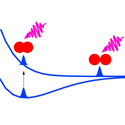Halfway between an atom and a molecule
Atoms and molecules typically ionize on time scales that are much less than s. Increasingly, researchers have visualized the ionization process, as well as more complex chemical reactions, with ultrafast pump-probe techniques, in which the atom or molecule is first excited optically and then its electronic structure is probed with a high-frequency laser pulse.
In Physical Review Letters, Philippe Wernet and colleagues at the Helmholtz-Zentrum Berlin in Germany, in collaboration with Stockholm University, Sweden, report pump-probe measurements that allow them to map out, in real time and with high time resolution, the structure of the valence electrons of a diatomic molecule as it ionizes. To measure the electronic bonds in the molecule and determine the time at which they break, they first excite the with a UV laser, then generate a femtosecond pulse from the harmonic of the laser that probes the valence electrons at various delay times after the first excitation.
Other groups have used the same technique to study the ionization process in , but with roughly half the time resolution of that currently reported by Wernet et al. This may explain why Wernet et al. find that the time it takes for to dissociate— with about of uncertainty—is significantly longer than what was previously determined.
These and other measurements are advancing steadily with the availability of high-intensity coherent light sources and provide fundamental tests of real-time simulations of atoms and molecules as they make, and break, bonds. – Jessica Thomas





